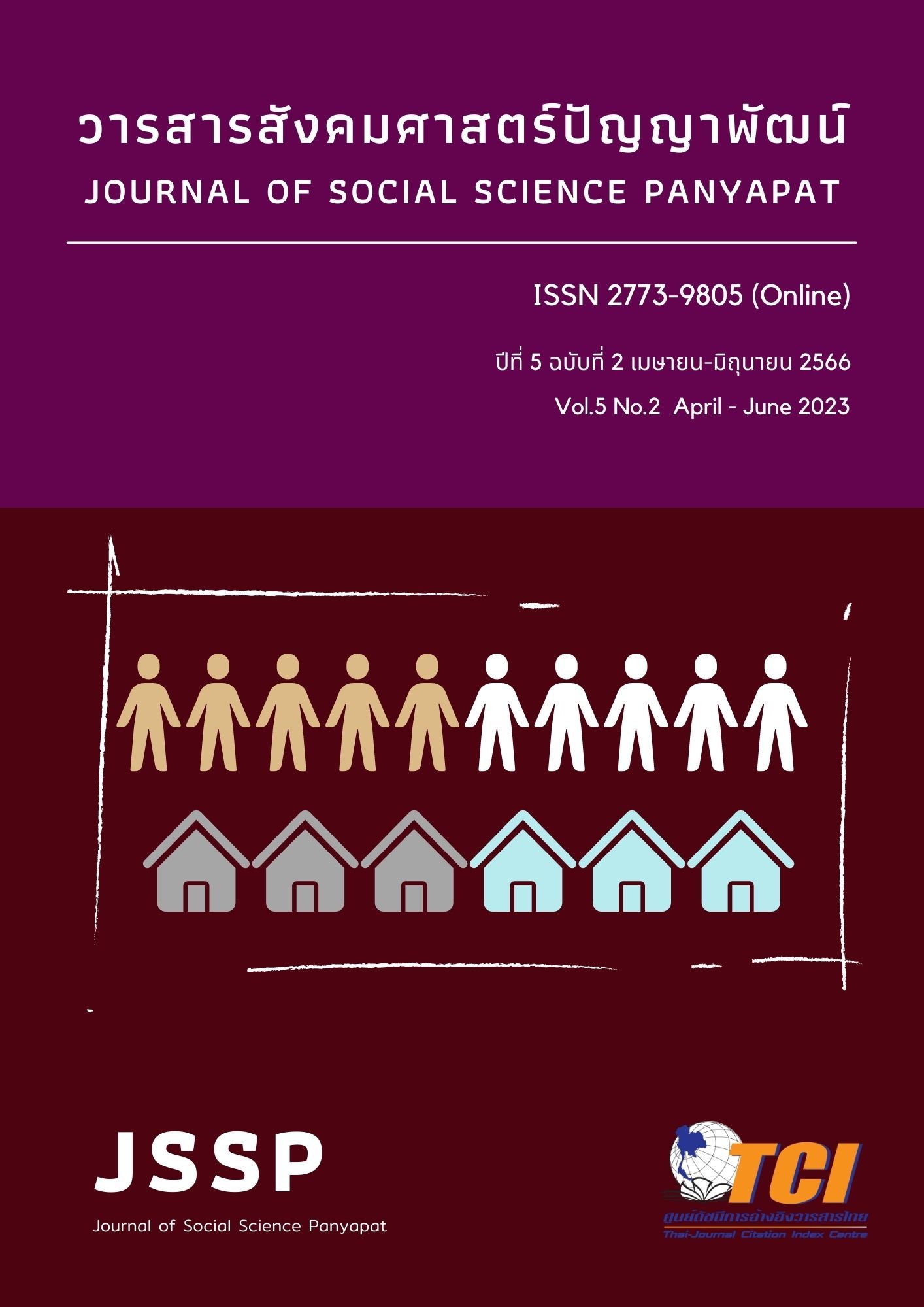World Heritage City and Cultural Identity for Tourism: A Case Study of Muangkao, Sukhothai Province
Keywords:
World Heritage City, Cultural Identity, Tourism, Sukhothai ProvinceAbstract
This research article aimed to study the context of the area leading to the search for cultural identity around Old City Subdistrict Sukhothai Province. The result of the study found that the context of the area was the location of the first kingdom of Thailand with named "The Dawn of Happiness". Nowadays Sukhothai is one of tourist destination of the world. The identity of the area is both tangible cultural heritage and intangible cultural heritage including with the community has a cultural heritage identity that can be divided into 3 aspects as follows: 1) Craft and Folk Arts Cultural Identity is outstanding in the local wisdom of creating the arts work such as Sukhothai pottery (Sangkhalok), wood carving, the Pra Ruang menus of the Ban Muang Kao community also buddha amulets of Ban Chetuphon community. These are reflecting the identity of local wisdom culture within terms of Experiencing Tourism Value. 2) Cultural Landscape Identity which means outstanding geographical-cultural area related to wisdom and knowledge to build the ancient old town, old city walls and the ancient dam (Phra Ruang Dam) were linked to the beautiful landscape and nature of Khao Luang Sukhothai or Ramkhamhaeng National Park named of King Ramkhamhaeng the Great that reflects the cultural landscape of Ban Monkhiri community to create for Recreational Tourism Value. 3) Historical - Sociocultural Identity means prominence as a historical site. It was originated of settlement of Sukhothai’s community in the past and found many ancient kilns that used to be the production of Sukhothai pottery. Nowadays, the Ban Si Chum community has become an important source of educational learning area, reflects the ancient and prosperous Sukhothai civilization which has now become educational learning area to create for Historical Tourism Value.
References
กระทรวงวัฒนธรรม. (2563). ประเพณีลอยกระทง เผาเทียนเล่นไฟสุโขทัย มรดกโลก. สืบค้น 15 มกราคม 2566. จาก https://www.finearts.go.th/storage/contents/2020/10/file/jTzvNLGEAc5gwwaOPuNuB0lSIBbUnQT0MmL0OE75.pdf.
กุลแก้ว คล้ายแก้ว. (2557). การจัดการท่องเที่ยวเชิงวัฒนธรรมภายใต้บริบทการเป็นเมืองมรดกโลก: แนวความคิดเห็นของผู้มีส่วนจัดการของชุมชนเมืองหลวงพระบาง สาธารณรัฐประชาธิปไตยประชาชาชนลาวและชุมชนเมืองเก่า อำเภอเมือง จังหวัดสุโขทัย (รายงานการวิจัย). พิษณุโลก: คณะวิทยาการจัดการ มหาวิทยาลัยราชภัฎพิบูลสงคราม.
กุลแก้ว คล้ายแก้ว. (2565). เอกสารคำสอนรายวิชา TOUR421 การท่องเที่ยวมรดกโลก. พิษณุโลก: คณะวิทยาการจัดการ มหาวิทยาลัยราชภัฏพิบูลสงคราม.
คณะกรรมการสถิติสาขาการท่องเที่ยวและกีฬา. (2558). แผนพัฒนาสถิติสาขาการท่องที่ยวและกีฬา ฉบับที่ 1 พ.ศ.2556-2558. สืบค้น 6 มิถุนายน 2565. จาก http://osthailand.nic.go.th/files/economic_sector/8.tourist.pdf.
จิรวัฒน์ พิระสันต์, พัชรินทร์ สิรสุนทร, ดำรงค์วุฒิ วิริยะ, วีรวิทย์ ฉันทวรางค์ และ ณธษา ศรัทธา. (2555). การพัฒนาชุมชนรอบอุทยานประวัติศาสตร์สุโขทัยแบบมีส่วนร่วมโดยใช้องค์ความรู้ทางด้านวัฒนธรรมเพื่อการท่องเที่ยว (รายงานการวิจัย). กรุงเทพฯ: สำนักงานคณะกรรมการส่งเสริมวิทยาศาสตร์ วิจัย และนวัตกรรม.
จิรวัฒน์ พิระสันต์. (2554). คู่มืออัตลักษณ์ชุมชนรอบอุทยานประวัติศาสตร์สุโขทัย. สถานอารยธรรมศึกษาโขง-สาละวิน มหาวิทยาลัยนเรศวร. พิษณุโลก: ดวงดาวการพิมพ์.
ฉลาดชาย รมิตานนท์. (2550). อัตลักษณ์วัฒนธรรมและการเปลี่ยนแปลง. เชียงใหม่: มหาวิทยาลัยเชียงใหม่.
ฉัตรกมล ปิยะจารุพร. (2562). ชุดความรู้ เรื่อง การปกป้องมรดกทางวัฒนธรรม (Cultural Heritage Protection). กรุงเทพฯ: องค์การพัฒนาพิ้นที่พิเศษเพื่อการท่องเที่ยวอย่างยิ่งยืน (องค์การมหาชน).
ธงชัย สาโค. (2564). สุโขทัยเมืองพระร่วง หลักฐานใหม่ : จากเตาสังคโลกเมืองเก่าสุโขทัย. กรุงเทพฯ: กรมศิลปากร กระทรวงวัฒนธรรม.
ภานุ สรวยสุวรรณ. (2555). การวิเคราะห์สุนทรียภาพในพระพุทธรูปสุโขทัยด้วยหลักการทางทัศนศิลป์. วารสารเวอริเดียน e-journal, 5(1), 21-44.
มาเรียม นิลพันธ์. (2558). ระเบียบวิธีวิจัยทางการศึกษา. นครปฐม: ภาควิชาหลักสูตรและการสอน คณะศึกษาศาสตร์ มหาวิทยาลัยศิลปากร.
วรรณดี สุทธินรากร. (2556). การวิจัยเชิงปฏิบัติการ: การวิจัยเพื่อเสรีภาพและการสร้างสรรค์. กรุงเทพฯ: สยามปริทัศน์.
วรรณวีร์ บุญคุ้ม. (2563). เอกสารประกอบการสอนรายวิชา 464611 สถิตขั้นสูงและวิธีวิจัยทางการจัดการนันทนาการ การท่องเที่ยวและกีฬา. นครปฐม: คณะศึกษาศาสตร์ มหาวิทยาลัยศิลปากร.
วัชรพล ชุมดวง. (2561). การบูรณาการการท่องเที่ยวเชิงสร้างสรรค์ด้วยต้นทุนมรดกทางวัฒนธรรม ด้วยกระบวนการมีส่วนร่วมของชุมชน กรณีศึกษาชุมชนเมืองเก่าสุโขทัย. วารสารครุศาสตร์อุตสาหกรรม, 17(3), 30-39.
ศรีศักร วัลลิโภดม. (2552). เมืองโบราณในอาณาจักรสุโขทัย. (พิมพ์ครั้งที่ 2). กรุงเทพฯ: เมืองโบราณ.
ศักดิ์ชัย สายสิงห์. (2560). เจดีย์ในประเทศไทย : รูปแบบ พัฒนาการและพลังศรัทธา. นนทบุรี: เมืองโบราณ.
ศุภลักษณ์ สนธิชัย. (2556). 100 มรดกโลก 100 World Heritage Travel around the world. กรุงเทพฯ: อทิตตา พลับลิเคชั่น.
ศูนย์ข้อมูลมรดกโลก. (2565). เมืองประวัติศาสตร์สุโขทัยและเมืองบริวาร. สืบค้น 6 มิถุนายน 2565. จาก http://164.115.22.96/heritage_culture.aspx.
ศูนย์มานุษยวิทยาสิรินธร (องค์การมหาชน). (2565). พิพิธภัณฑ์สังคโลก.สืบค้น 6 มิถุนายน 2565. จาก https://db.sac.or.th/museum/museum-detail/538.
สันติ เล็กสุขุม. (2551). โบราณสถานกับรูปแบบสันนิษฐานมรดกโลกสุโขทัย ศรีสัชนาลัยและกำแพงเพชร 2. กรุงเทพฯ: ทวีวัฒน์การพิมพ์.
สันติ เล็กสุขุม. (2561). สุโขทัย : เจดีย์อินคัลเลอร์. กรุงเทพฯ: โรงพิมพ์มติชนปากเกร็ด.
สำนักงานการท่องเที่ยวและกีฬาจังหวัดสุโขทัย. (2564). สถิติจำนวนนักท่องเที่ยวจังหวัดสุโขทัย พ.ศ.2562. สุโขทัย: สำนักงานการท่องเที่ยวและกีฬาจังหวัดสุโขทัย.
สำนักงานจังหวัดสุโขทัย. (2565). คู่มือแผนพัฒนาจังหวัดสุโขทัย พ.ศ.2566-2570: กลุ่มงานยุทธศาสตร์และข้อมูลเพื่อการพัฒนาจังหวัด สำนักงานจังหวัดสุโขทัย. สุโขทัย: สำนักงานจังหวัดสุโขทัย.
สำนักงานสภาพัฒนาการเศรษฐกิจและสังคมแห่งชาติ. (2565). (ร่าง) แผนพัฒนาศรษฐกิจและสังคมแห่งชาติ ฉบับที่ 13 (พ.ศ. 2566 – 2570). สืบค้น 6 มิถุนายน 2565. จาก https://www.nesdc.go.th/download/document/Yearend/2021/plan13.pdf.
สำนักหอสมุดแห่งชาติ กระทรวงวัฒนธรรม (2554). คู่มือการอ่านถ่ายถอดลายสือไทย พ่อขุนรามคำแหงมหาราช. สืบค้น 6 มิถุนายน 2565. จาก https://pubhtml5.com/iytc/tucb/.
สิทธิพล เครือรัฐติกาล. (2551). แนวคิดเรื่อง Soft power และการทูตสาธารณะ (Public diplomacy). สืบค้น 3 มิถุนายน 2565. จาก http://kositthiphon.blogspot.com/2008/12/soft-power-public-diplomacy.html.
สืบค้น 6 มิถุนายน 2565. จาก https://sukhothai.mots.go.th/.
สุภางค์ จันทวานิช. (2552). วิธีการวิจัยเชิงคุณภาพ. กรุงเทพฯ: จุฬาลงกรณ์มหาวิทยาลัย.
องค์การบริหารการพัฒนาพื้นที่พิเศษเพื่อการท่องเที่ยวอย่างยั่งยืน. (2565). สุโขทัยเมืองสร้างสรรค์ด้านศิลปะและหัตกรรมพื้นบ้าน (Sukhothai city of Folk Art and Craft). สืบค้น 6 มิถุนายน 2565. จาก https://www.file:///C:/Users/introduction sukhothai.pdf.
องค์บริหารส่วนตำบลเมืองเก่า. (2565). แผนพัฒนาท้องถิ่น (พ.ศ.2566-2570) ขององค์การบริหารส่วนตำบลเมืองเก่า อำเภอเมืองสุโขทัย จังหวัดสุโขทัย. สืบค้น 6 มิถุนายน 2565. จาก https://www.mueangkao.go.th/otop.php?start=1.
Berg, B. L. (2001). Qualitative research methods for the social sciences. U.S.A.: Allyn & Bacon.
Denzin, N. (1970). Sociologocal Methods : A Source Book. Chicago: Aldine.
Lincoln, G. (1985). Naturalistic Inquiry. Beverly Hills: CA: SAGE.
Moser A., K. I. (2018). Series: Practical guidance to qualitative research. European Journal of General Practice, 24(1), 9-18.
Nye, Jr., Joseph S. (2004). Soft Power: The Means to Success in World Politics. New York: Public Affairs.
Richards, G. (2010). Creative Tourism and Local Development. Retrieved 6 June 2022. from http://goodthinking.com.au/Wordpress/wp-content/uploads/2022/02/Creative_Tourism_and_Local_Development-2.pdf.
Richards, G., and Wilson, J. (2006). Developing creativity in tourist experiences: A solution to the serial reproduction of culture. Tourism management, 27, 1209-1223.
Downloads
Published
How to Cite
Issue
Section
License
Copyright (c) 2023 Journal of Social Science Panyapat

This work is licensed under a Creative Commons Attribution-NonCommercial-NoDerivatives 4.0 International License.


